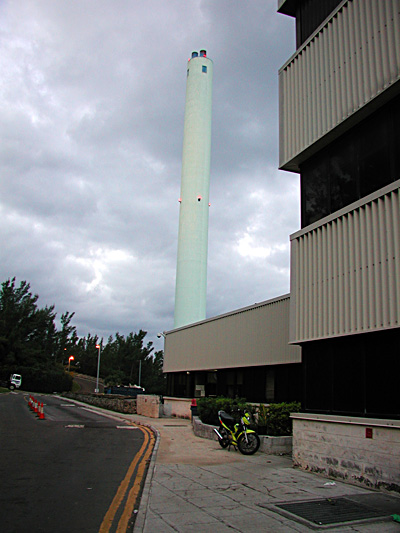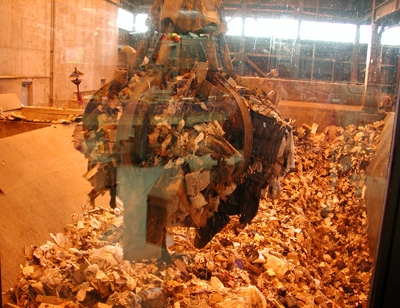


Tynes Bay Waste Treatment Facility, built in 1995 by Von Roll Inova, is part of the Bermudian Governments "Works and Engineering Department". The continuous operation of reducing the island's refuse requires a crew consisting of a second or first class supervisor and at least 3 process controllers, made up of trainees and operators eventually requiring third class engineering certification. It involves shift work as this is a 24 hour seven days a week operation based on a 35 hour work week.
Pictured at left is the front door to the facility, showing the smoke stack and weigh scales for the incoming trucks. Inside the stack are provision for three flues, two of which are in place and used to date.
As you've probably figured out, we burn garbage! Municipal and Commercial waste is trucked on a daily basis to the incinerator. We generate our own power and charge for dumping to pay for the cost of operation.
The facility also includes a "Public Drop-off" which is open every day of the year. This is where the public can drop off their garbage, recycling, hazardous goods, refrigerators, old air conditioners, computers, tv's, etc.
If you would like to see an illustration of how the facility works click here! You will be asked to install a small file. It is safe, I assure you :) Wait for a moment and descriptions will appear for each process.

The control room includes the operation of the Crane whereby the "grab" picks up refuse from the bunker and delivers it to each boiler's "feed hopper".
At present we have two Boilers in continuous operation to keep up with the inflow of refuse. If one of the boilers is "off line" because of tube repairs or other problems, then the bunker fills up with garbage within a short time. Plans have been approved to construct a "Third Stream" including a third Boiler and another Turbo-alternator.
Pictured at left are the two control chairs, one for each crane or "grab". A typical shift would have an operator operate one grab for a 3 or 4 hour period, and then hand over the controls to another engineer. Mixing the fuel and feeding it to the boilers is a continuous and important part of the operation.

At right is another picture of the Bunker where you can see the depth reaching "close" to the bottom. The Bunker is 57 feet deep and 33 feet wide by 98 feet long. It can hold 6,000 tonnes of refuse, which is about 5 weeks of garbage. The grab or "Claw" can lift up to 5.8 tonnes.
The refuse consists of only burnable waste, although some rather large metal chunks often get through. No animal carcases get burned and anything that can cause a negative impact on the air emissions are not incinerated. Waste that is too large to feed into the boilers, such as chesterfields, furniture, pallets, etc., are chopped up in the "Bulky Shear."

Pictured above is the burner door of Boiler #1. It is open now because the boiler is down for maintenance. A regular duty of the engineer is to look through a window in this door to inspect the fire. (Mouse over the image above) Also shown (foreground) is one of the ash hoppers, this one from the super heater section. On a regular timed schedule a system of "rappers" bang the pipe supports and shake loose the ash. All the ash, including what drops off the end of the fire-grate in the furnace, drops into a "Quench Tank" and is conveyed to the "Ash Plant".
At left is what the fire looks like when looking trough the door. At the back is the fire itself and closer is the resulting ash as it makes it's way down the fire grate. Click on the image to see the fire up close.
What is our capacity? 288 tonnes of refuse can be burned each day with both streams in operation. That's 6 tonnes per hour per boiler (about 2 full garbage trucks).
See in the image to your right the gauges on top of one boiler steam drum showing pressure of the drum itself, the super heater outlet and the temperature of the superheated steam. To see the readings clearly, click on the image. This is on the very top of the boiler structure, which is very hot (especially in the summer) and 12 levels high (about 7 stories). There is an elevator to the 5th level but from there it's a climb.

At left we see the base foundation of one of the boilers in the form of the "quench tank". Everything that is left after the burning process ends up here. The amount of ash produced daily depends on the amount of garbage burned and the quality and moisture content of the refuse. The heat content of municipal and commercial garbage is increasing world wide largely due to prepackaging. Here in Bermuda, we also handle all the garbage from the Cruise Ships.
One tonne of garbage is reduced to 1/10th of the volume and 1/3rd of the weight, so that at full capacity one stream of the plant will generate 48 tonnes of ash a day. This ash is processed in the "Ash Plant" whereby it's mixed with cement and poured into "blocks" which are used to build walls under water for land reclamation.
For more information on this; click here!
Here we see a picture of the feed pumps.Two electric pumps are backed up by a steam turbine.
The make up water requirements are not great as most of the steam is condensed in the condensers and returned as pure condensate.
Above we see a view of the turbine from above and it's control panel. As before, if you wish to see details of gauges, etc., just click on the images to get a blow up of the same image.
The high pressure steam from the boilers drive this turbine which turns the alternator to generate power for the plant. Enough power is generated to power everything at the Tynes Bay Facility and also feed the grid. Plans for the "Third Stream" include the construction of a much larger turbo-alternator which will be a considerable source of electricity for the Island of Bermuda.
A view to the left is of one of the Induction Fans which draw the products of combustion through the boiler and electrostatic precipitator.
Monitoring equipment continuously measure temperature, oxygen, carbon monoxide, sulphur dioxide, hydrogen chloride and opacity to establish that emissions remain within permitted limits.
At right is the "Stack". Inside, one can climb to the top via an inside staircase.
There are 30 employees, working in combinations of 8 hour day shifts (Eg.-maintenance, Electrical & Instrumentation, Ash plant, office, weigh scale) and 12 hour shift engineers working continuously. There is as many as 14 employees at any one time and as few as four engineers on night shift.
I hope you've enjoyed this little tour through Bermuda's Tynes Bay Waste Treatment Facility.